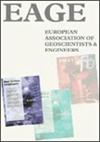The utilisation of ghost reflections retrieved by seismic interferometry for layer‐specific characterisation of the shallow subsurface
IF 1.6
4区 地球科学
Q3 GEOCHEMISTRY & GEOPHYSICS
引用次数: 0
Abstract
Seismic interferometry (SI) retrieves the Green's function between two receiver locations using their recordings from a boundary of sources. When using sources and receivers only at the surface, the virtual‐source gathers retrieved by SI contain pseudo‐physical reflections as well as ghost (non‐physical) reflections. These ghost reflections are the results of the cross‐correlation or auto‐correlation of primary reflections from two different depth levels, and they contain information about the seismic properties of specific layers in the subsurface. We investigated the application of ghost reflections for layer‐specific characterisation of the shallow subsurface using SI by auto‐correlation. First, we showed the technique's potential using synthetic data for a subsurface model with a lateral change in velocity, a gradient in depth for velocity, a thickness change, and a velocity change of the target layer. Then, we applied the technique to shallow subsurface field data. We also focused on improving the retrieval of ghost reflections by removing the free‐surface multiples and muting undesired events in active‐source gathers before applying SI. Our results demonstrate that the ghost reflections can be used advantageously to characterise the layer that causes them to appear in the results of SI. Consequently, they can also provide valuable information for imaging and monitoring shallow subsurface structures.This article is protected by copyright. All rights reserved利用地震干涉测量法反演的鬼影反射对浅层地下进行层特异性表征
摘要地震干涉测量法(SI)利用两个接收机在震源边界上的记录来获取二者之间的格林函数。当仅在地表使用源和接收器时,SI检索的虚拟源集包含伪物理反射和鬼(非物理)反射。这些鬼反射是来自两个不同深度的主反射相互相关或自相关(AC)的结果,它们包含有关地下特定层的地震特性的信息。我们研究了鬼影反射的应用,利用AC的SI对浅层地下进行层特异性表征。首先,我们利用地下模型的合成数据展示了该技术的潜力,该模型具有速度的横向变化、速度的深度梯度、厚度变化和目标层的速度变化。然后,我们将该技术应用于浅层地下油田数据。我们还着重于在应用SI之前通过去除自由面倍数和抑制有源聚集中的不希望发生的事件来改善鬼反射的检索。我们的结果表明,鬼反射可以很好地用来表征导致它们出现在SI结果中的层。因此,它们也可以为成像和监测浅层地下结构提供有价值的信息。
本文章由计算机程序翻译,如有差异,请以英文原文为准。
求助全文
约1分钟内获得全文
求助全文
来源期刊

Near Surface Geophysics
地学-地球化学与地球物理
CiteScore
3.60
自引率
12.50%
发文量
42
审稿时长
6-12 weeks
期刊介绍:
Near Surface Geophysics is an international journal for the publication of research and development in geophysics applied to near surface. It places emphasis on geological, hydrogeological, geotechnical, environmental, engineering, mining, archaeological, agricultural and other applications of geophysics as well as physical soil and rock properties. Geophysical and geoscientific case histories with innovative use of geophysical techniques are welcome, which may include improvements on instrumentation, measurements, data acquisition and processing, modelling, inversion, interpretation, project management and multidisciplinary use. The papers should also be understandable to those who use geophysical data but are not necessarily geophysicists.
 求助内容:
求助内容: 应助结果提醒方式:
应助结果提醒方式:


